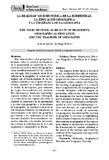Mostrar el registro sencillo del ítem
La realidad sociohistórica de la modernidad, la educación geográfica y la enseñanza de la geografía
| dc.rights.license | http://creativecommons.org/licenses/by-nc-sa/3.0/ve/ | es_VE |
| dc.contributor.author | Santiago Rivera, José Armando | |
| dc.date.accessioned | 2018-06-21T05:06:24Z | |
| dc.date.available | 2018-06-21T05:06:24Z | |
| dc.date.issued | 2017 | |
| dc.identifier.issn | 1690-3544 | |
| dc.identifier.uri | http://www.saber.ula.ve/handle/123456789/45043 | |
| dc.description.abstract | Este artículo tiene como propósito reflexionar sobre la realidad sociohistórica de la modernidad, en condición de escenario del inicio de la educación geográfica como finalidad formativa de los ciudadanos del siglo XIX, facilitada desde la enseñanza de la geografía. Se asume que se originó con el fortalecimiento de las disciplinas científicas con el apoyo del positivismo, mientras en el ámbito educativo se utilizó la descripción, para enumerar los rasgos físico-naturales del territorio. Esta discrepancia determinó metodológicamente realizar la revisión bibliográfica y estructurar una explicación sobre la realidad sociohistórica de la modernidad y la educación geográfica y la enseñanza de la geografía. Se concluye al destacar en este momento histórico, las influencias de eurocentrismo en la educación geográfica para formar a los ciudadanos en un acto educante limitado a la transmisión de contenidos, referidos a los detalles del territorio y evadir la visibilización de la acción hegemónica e imperialista de Europa. | es_VE |
| dc.language.iso | es | es_VE |
| dc.rights | info:eu-repo/semantics/openAccess | es_VE |
| dc.subject | Modernidad | es_VE |
| dc.subject | Educación Geográfica y Enseñanza de la Geografía | es_VE |
| dc.title | La realidad sociohistórica de la modernidad, la educación geográfica y la enseñanza de la geografía | es_VE |
| dc.title.alternative | The socio-historical reality of modernity, geographical education and the teaching of geography | es_VE |
| dc.type | info:eu-repo/semantics/article | es_VE |
| dcterms.dateAccepted | 02/12/2017 | |
| dcterms.dateSubmitted | 28/10/2017 | |
| dc.description.abstract1 | The purpose of this article is to reflect on the sociohistorical reality of modernity, as the setting for the beginning of geographical education as a formative goal of nineteenth century citizens, facilitated by the teaching of geography. It is assumed that it originated with the strengthening of scientific disciplines with the support of positivism, while in the educational field the description was used to enumerate the physical-natural features of the territory. This discrepancy determined methodologically to carry out the bibliographic review and structure an explanation about the sociohistorical reality of modernity and geographic education and the teaching of geography. It concludes by highlighting in this historical moment, the influences of Eurocentrism in geographical education to train citizens in an educative act limited to the transmission of content, referring to the details of the territory and evade the visibility of the hegemonic and imperialist action of Europe. | es_VE |
| dc.description.colacion | 261-277 | es_VE |
| dc.description.email | asantia@ula.ve | es_VE |
| dc.description.frecuencia | Anual | |
| dc.identifier.depositolegal | 2002TA1412 | |
| dc.publisher.pais | Venezuela | es_VE |
| dc.subject.facultad | Núcleo Táchira (NUTULA) | es_VE |
| dc.subject.institucion | Universidad de Los Andes | es_VE |
| dc.subject.keywords | Modernity | es_VE |
| dc.subject.keywords | Geographical Education and Geography Teaching | es_VE |
| dc.subject.seccion | Heurística: Artículos | es_VE |
| dc.subject.thematiccategory | Ciencias Económicas y Sociales | es_VE |
| dc.subject.tipo | Revistas | es_VE |
| dc.subject.unidadinv | Grupo de Investigación de Historia de la Educación y Representaciones (HEDURE) | es_VE |
| dc.type.media | Texto | es_VE |
Ficheros en el ítem
Este ítem aparece en la(s) siguiente(s) colección(ones)
-
Heurística - Número 020
enero - diciembre 2017


